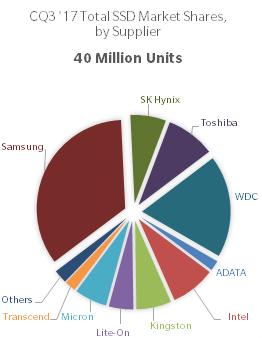 |
| leading the way to the
new storage frontier | |
... |
| ..... |
|
industrial
SSDs - boring right?
after AFAs -
what's the next box?
DWDP - examples from
the market
3D
nand fab yield - the nth layer tax?
how fast can your SSD
run backwards?
who's
who in the SSD market in China?
capacitor
hold up times in 2.5" military SSDs
where are we
heading with memory intensive systems?
miscellaneous
consequences of the 2017 memory shortages |
|
| ... |
|
2017 - adding new notes to
the music of memory tiering
by
Zsolt Kerekes,
editor - November 14, 2017 |
I think that developments in the SSD and
memory systems markets in 2017 will have as profound an effect on the future of
the data systems market and the direction of its architecture and software as
the adoption of flash SSDs in enterprise storage had on the design of
hard disk arrays and the
design of server motherboards.
Although many of the influences to this
new fork in the road had been nurturing for several years before this for
example:-
- competing software solutions for memory tiering
- the availability of 3 to 5 nvm alternatives to flash, and
- mainstream market acceptance of solid state storage at the heart of
enterprise storage engineering
it was the accidental convergence or
crashing together of alt nvms as usable modules (in DIMMs, M.2 SSD and PCIe
SSD form factors) in the same year as the
statistically
inevitable but accidental and unpredicted market force - the shortage of
flash (with its attendant price hikes which had the effect of making alt-nvms
look 2 -3 years better and more competitive than they had been in the all the
years before) - which made the lasting difference. From here on thinking about
the internal make up and external presentation of memory systems would be
materially different.
 After
2017 - memoryfication solutions (tiering at the board, box and cloud level)
will no longer be restricted to the same old tunes restricted by the paucity
of melodies obtainable from DRAM, flash and the intervening interface
dynamics. After
2017 - memoryfication solutions (tiering at the board, box and cloud level)
will no longer be restricted to the same old tunes restricted by the paucity
of melodies obtainable from DRAM, flash and the intervening interface
dynamics.
Designers can now count on a new set of notes and
arrangements to provide data harmonies which were hitherto extravagant to
realize with the two old mainstay memory technologies with their well understood
limitations of space, power consumption and raw latency. (Although many
pioneering attempts at breaking these memory opera barriers came with a
supporting cast of batteries and extra cooling technologies hidden behind the
stage curtain.)
While no one can guarantee that MRAM, ReRAM or 3DX /
Optane will all continue to be available and competitive in multiple future
generations - the continued future existence of any one particular alternative
to flash and DRAM is less significant than the balance of probability that there
are enough technologies out there (and coming in the works) to make it
worthwhile for software and hardware designers to apply their minds to enriching
the vocabulary of their architecture song books.
If I can use another
analogy - 19th century chemists made great strides in their anticipation of all
possible elements when they constructed the periodic table. For over a decade
the SSD market (and its SSD product atoms) has been both enabled but also
limited by the combination of building blocks which designers could construct
with 2 distinct memory types - subject to the constraints of the atomic forces
(price, wattage and ratios of capacity and latency between DRAM, flash and all
rotating storage) which set the boundaries of which architectural permutations
of components were viable at any point in time.
Looking ahead - the
availability of new memories in the mix and the willingness of designers to
leverage their features to create virtualizable benefits could be as
significant to the datasystems market as the advent of additive technologies (3D
printing) to the creation of new materials with characteristics which weren't
imaginable with traditional elements and compounds. | | |
|
| ... |
|
 |
|
... |
|
| One of the comforting
things about the industrial SSD market before 2017 was that products didn't
change much from one year to the next. But new applications and technologies for
rugged SSDs will change that picture. |
| say
farewell to reassuringly boring industrial SSDs | | |
|
... |
|
|
|
|
... |
|
 |
|
... |
|
|
|
|
... |
|
|
|
| |
|
|
| ... |
 |
| ... |
|
more pages like
this? |
| ... |
Next Platform reports on big NVMe ideas
seen at SC17
Editor:- November 28, 2017 - Newisys (whose 15 million IOPS, 60GB/s
2U rackmount NVMe SSD platform with Intel's Optane inside
won an award at last summer's Flash
Memory Summit) is one of several companies mentioned in a new
article -
Assessing
the Tradeoffs of NVMe Storage at Scale (a report on
SC17 in the Next Platform)
written by its Senior Editor - Jeffrey
Burt who has written
many articles about high
performance storage.
Everspin says it will make STT-MRAM more competitive
Editor:-
November 15, 2017 - A
story
on MRAM-info.com says that Everspin has decided
to delay the introduction of its 1Gb STT-MRAM devices and instead focus on its
256Mb chips which are already in production.
In Everspin's recently
announced
financial results press release the company's CEO said the company is
progressing from being "a developer of innovative MRAM technology into one
that can develop markets, scale operations and reduce costs to compete..."
PCIe SSDs (enterprise and notebook M.2) did well in Q3
Editor:-
November 15, 2017 - TrendFocus
today published
SSD
market shipment data for Q3 2017.
Only one segment, enterprise
PCIe, saw unit growth where every other segment – client drive format
factor, client modules, enterprise SATA and enterprise SAS, all declined from
the prior quarter.
 The
enterprise SSDs market declined 7% Q-Q, which includes
SATA,
SAS and
PCIe. The bright spot
within this overall decline was the healthy 15.6% increase in PCIe units. As
hyperscale companies continue to migrate away from SATA, PCIe should continue to
grow in both units and exabytes. SATA, still the highest volume of all
enterprise categories, managed to stay just above 4 million units shipped but
did decline sharply in CQ3. However, exabytes shipped in the SATA SSD market
grew due to the transition to higher capacity units. SAS SSDs now represent the
lowest unit volume of the enterprise SSD segments, but still maintain a large
lead in average capacity shipped at over 2.1 terabytes. The
enterprise SSDs market declined 7% Q-Q, which includes
SATA,
SAS and
PCIe. The bright spot
within this overall decline was the healthy 15.6% increase in PCIe units. As
hyperscale companies continue to migrate away from SATA, PCIe should continue to
grow in both units and exabytes. SATA, still the highest volume of all
enterprise categories, managed to stay just above 4 million units shipped but
did decline sharply in CQ3. However, exabytes shipped in the SATA SSD market
grew due to the transition to higher capacity units. SAS SSDs now represent the
lowest unit volume of the enterprise SSD segments, but still maintain a large
lead in average capacity shipped at over 2.1 terabytes.
Client SSD
shipments fell 4.5% sequentially but exabytes shipped was flat. Client modules
now represent almost 2/3 of all client SSDs shipped. Even more impressive within
this segment is that M.2
PCIe is now 50% of this segment – illustrating the continued migration for
major Notebook
OEMs to integrate with this interface.
3D NAND accounted for more than
50% of all bits shipped for the first time in CQ3, as all of the NAND suppliers
are well into the transition.
IntelliProp demonstrates Gen-Z memory controller
Editor:-
November 13, 2017 - IntelliProp
today
announced
demonstrations of 2 new controller IPs.
- A memory controller for the emerging Gen-Z memory interface.
IntelliProp's
Gen-Z IPA-PM185-CT "COBRA" controller combines DRAM and NAND and
sits on the Gen-Z fabric, not the memory bus. COBRA has the ability to support
byte addressability to DRAM cache and Block addressability to NAND flash.
COBRA-based Gen-Z memory modules provide low latency, persistent, shared memory
access to multiple processors and accelerators on the Gen-Z fabric supporting up
to 32GB of DRAM and 3TB of NAND.
- An NVMe 1.3 compatible host accelerator IP core.
IntelliProp's
IPC-NV164-HI for for Xilinx and Altera FPGAs accelerates performance by
off-loading command and completion queue management from the processor to
hardware.
Enmotus tiers NVDIMMs with NVMe flash at SC17
Editor:-
November 13, 2017 - Enmotus
today
announced
it is demonstrating a fully automated tiered volume with 2 million IOPS
performance using NVDIMMs and NVMe flash technology from Micron at the SC17
Conference being held this week in Denver, Colorado.
"Enmotus' FuzeDrive Virtual SSD Software combines the NVDIMMs and
NVMe flash into a single, fully automated virtual volume," said
Andy Mills, CEO of
Enmotus. "The software identifies the active data set of applications, and
dynamically allocates the appropriate storage resources to optimize performance."
Qualcomm invests in Excelero
Editor:- November 7,
2017 - Excelero today
announced
a strategic investment from Qualcomm Ventures which brings the total of VC funds
invested in Excelero to $30 million.
"NVMe SSDs and innovations
like 3DXpoint need new scale-out architectures so that IT teams can consolidate
resources enterprise-wide into flexible and reliable infrastructures, without
compromise," said Lior
Gal, CEO and co-founder of Excelero. "We're proud to receive the
ultimate vote of confidence from esteemed strategic investors such as Qualcomm
Ventures – leaders who are driving innovation in data center technologies.
We look forward to building out our offering and helping enterprises to deploy
the hyperscale data center of tomorrow."
SSD software,
VC funds in SSD,
after AFAs -
what's the next box?
AccelStor doesn't use capacitor holdup to boost new HA arrays
Editor:-
November 6, 2017 - The complex interdependencies between
capacitor
hold up time on
RAM flash caches
and performance
and reliability in
SSDs has been discussed many times in StorageSearch.com.
In an
announcement
today about its new 2U flash array for the
high availability
market - the
H510
(pdf) (array of 24 SATA SSDs with 8x 10GbE SFP+ or 4x 16G FC connectivity) -
AccelStor
said this...
"Some vendors adopt NVRAM as a write cache and use
supercapacitors to provide energy to write the RAM content into flash in the
event of a power failure. However, supercapacitors can still cause a single
point of failure. AccelStor aims to provide comprehensive data protection. With
the special write-through design, its NeoSapphire AFAs acknowledge the
completion of incoming I/O only when 100% of the data has been written on the
SSD."
AccelStor became known for their high performance arrays for
the performance
optimized market. The new H510 also includes data
security features
including cryptographic erase.
Many flash arrays includes some kind
of performance hit during software upgrades and maintenance. Accelstor says
its shared nothing architecture requires no maintenance window. "You can
simply perform the maintenance on a single node while receiving the full
performance and capabilities of the secondary node."
Editor's
comments:- I wrote about Accelstor's thinking about the use of NVMs and arrays
failover gotchas in
an interview
article last year. | |
| . |
|
|
| . |
 |
| . |
|

| |
| .. |
|
|
.. |
|
 |
|
.. |
|
SSD history is a mess.
I know I was there and I wrote the first draft of it.
But
there is an easy way to get the lessons of all that history of technical change
and market adoption by looking at 4 strategic before and after events. |
| strategic
bifurcations in SSD market history | | |
|
... |
|
|
|
.. |
|
.. |
|
| Are we
there yet? |
| After more than 20 years of writing guides to
the SSD and memory systems market I admit in a new blog on
StorageSearch.com -
Are
we there yet? - that when I come to think about it candidly the SSD
industry and my publishing output are both still very much "under
construction". ...read
the article | | |
|
.. |
|
| If you're one of those who
has suffered from the memory shortages it may seem unfair that despite their
miscalculations and over optimimism the very companies which caused the
shortages of memory and higher prices - the major manufacturers of nand flash
and DRAM - have been among the greatest beneficiaries. |
| consequences
of the 2017 memory shortages | | |
|
.. |
|
.. |
|
|
|
.. |
|
| after AFAs?
- the next box |
Throughout the
history of
the data storage market we've always expected the capacity of enterprise user
memory systems to be much smaller than the capacity of all the other attached
storage in the same data processing environment.
 A
new blog on StorageSearch.com
- cloud
adapted memory systems - asks (among other things) if this will always be
true. A
new blog on StorageSearch.com
- cloud
adapted memory systems - asks (among other things) if this will always be
true.
Like many of you - I've been thinking a lot about the
evolution of memory technologies and data architectures in the past year. I
wasn't sure when would be the best time to share my thoughts about this one.
But the timing seems right now. ...read the
article | | |
|
|
|
| |






 After
2017 - memoryfication solutions (tiering at the board, box and cloud level)
will no longer be restricted to the same old tunes restricted by the paucity
of melodies obtainable from DRAM, flash and the intervening interface
dynamics.
After
2017 - memoryfication solutions (tiering at the board, box and cloud level)
will no longer be restricted to the same old tunes restricted by the paucity
of melodies obtainable from DRAM, flash and the intervening interface
dynamics. 






